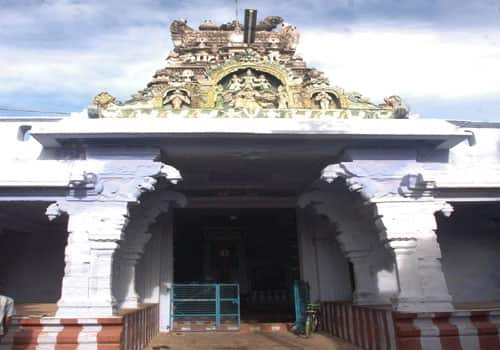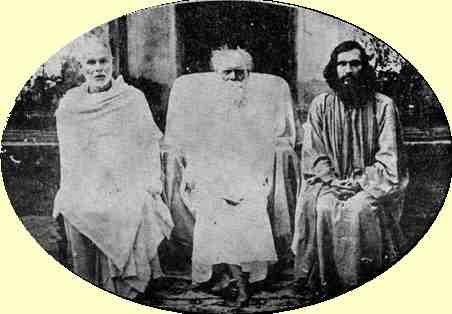In a book he wrote, Travel Letters From Ceylon, Australia and South India ( B. Westermann Co., New York, 1931), he remembered Thycaud Ayya Swamikal, the spiritual Guru. He shared this story:
"The senior of the two boys with some hesitation said "We have brought what you wanted" and took out something from his mundu and placed it on the table. It was a gold coin which probably they had purchased from the market. The guru's face became red with anger. Seeing this, the boys made a quick exit. The spy asked, "Sir, you should be happy since they have gifted you a gold coin. Why are you angry ?"
"Then the guru said, "They are making fun of me. They think I am greedy for gold. They do not understand my real purpose. What I need is a certain plant for an alchemical experiment which requires this plant. The plant is only for cleaning the brass coin. The real transmutation process is psychical". The spy grabbed the golden opportunity. He offered to bring the plant. The guru at first was reluctant, saying that being a foreigner he may not be able to converse with the local people and get the plant. But the spy was very enthusiastic and at last, the guru told him the name of the plant. The spy hired a horse-drawn carriage, went to Maruthwamala and brought a carriage full load of the plant. This pleased the guru and he included the spy in the experiment in place of the two boys who never showed up again."
 |
| Walter Strickland, last portrait |
The spy was Walter William Strickland, who found Chempaka Raman Pillai and sent him to Germany.
There lived a Vellala couple Chinna Swami Pillai and Nagammal in Trivandrum in a house where the present Accountant General office is situated. Chempaka Raman alias Venkidi was born to them on 15 September 1891. Even during his Model school days he rallied against the British and shouted 'Jai Hind' on the school campus. Fearing retribution, the Principal called in the police. A Constable, Chinnaswami Pillai was sent to investigate the misdemeanour of the erring student. It turned out to be his own son.
 |
In his 1992 book Europe and India’s Foreign Policy, Verinder Grover writes:
“When the first World War broke out, Indian revolutionaries abroad attempted to seize the opportunity to enlist German support for India’s fight for freedom… The emigre Indian revolutionaries in Europe, prominent among them a young south Indian called Chempakaraman Pillai, contacted the German embassy in Zurich. In September 1914, the International Pro-India Committee was formed, with Pillai as the president and Zurich as headquarters.”
From Zurich, Pillai ran the German/English monthly Pro-India, a magazine that put forward the Indian view of the world to the German people.
In October 1914, Pillai travelled to Berlin where a group of Indians had founded the Berlin Committee in support of the Indian cause. The following year, the International Pro-India Committee and the Berlin Committee combined to form the Indian Independence Committee.
Raman took a degree in Public Governance and Economics from Germany. He lived in Germany for 20 years. He carried campaign against British rule in India, With Virendranath Chatopadhyaya, Lala Hardayal, Raja Mahendra Pratap, Dr Prabhakar, A R Pillai and A.C. N Nambiar he founded Indian Independence CommitteeA R Pillai was Novelist C V Raman Pillai's son in law; Nambiar was writer Vengayil Kunjiraman Nayanar's son. Armed with an Engineering diploma, Raman joined German Navy. He was an officer on the cruiser” Emden” and attacked British ships and shelled several places in India. On September 22,1914 Madras was shelled.
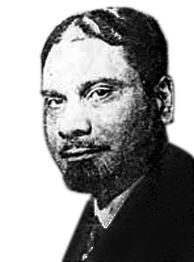 |
| Raman Pillai |
The mentor of Chempakaraman Pillai, Walter William Strickland (born Westminster 26 May 1851- died Java 9 August 1938 ) was the son of Sir Charles Strickland, 8th Baronet (1819–1909). He was the eldest son and the only child of his first marriage to Georgina, daughter of Sir William Milner, 4th Baronet, He was educated at Edinburgh Academy and Trinity College, Cambridge. He was the 9th Baronet, known as the Anarchist Baronet because he wandered around the world for much of his life espousing radical causes. The family estate was at Hildenley Hall in Yorkshire.
He married Eliza Vokes (1860–1946) in 1888. They had no children and the title passed to a cousin once removed, Sir Henry Strickland-Constable.
He wrote several books and pamphlets and translated works of the Czech poet Viteslav Halek, Moliere and Horace. He has been linked with the Voynich manuscript. He may have met Voynich during his first years in London, when Voynich was directly involved in the political activities of Russian refugees in London, under the leadership of Stepniak - Kravchinskii, who founded the SFRF (Society of Friends of Russian Freedom) and the RFPF (Russian Free Press Fund).
 |
| Wilfrid Voynich |
In 1885, in Warsaw, Wojnicz joined Ludwik Waryński's revolutionary organization, Proletariat. In 1886, after a failed attempt to free fellow conspirators, Piotr Bartowski (1846-1886) and Stanisław Kunicki (1861-1886), who had both been sentenced to death, from the Warsaw Citadel, he was arrested by the Russian police. In 1887, he was sent to penal servitude at Tunka near Irkutsk.
Whilst in Siberia, Voynich acquired a working knowledge of eighteen different languages, albeit not well.
In June 1890 he escaped from Siberia and travelling west by train got to Hamburg, eventually arriving in London in October 1890. Under the assumed name of Ivan Kel'chevskii at first, he worked with Stepniak, a fellow revolutionary, under the banner of the anti-tsarist Society of Friends of Russian Freedom in London. After Stepniak's death in a railway crossing accident in 1895, Voynich ceased revolutionary activity.
Voynich became an antiquarian bookseller around 1897, acting on the advice of Richard Garnett, a curator at the British Museum. Voynich opened a bookshop at Soho Square in London in 1898. He was remarkably lucky in finding rare books, including a Malermi Bible in Italy in 1902.
In 1902 he married a fellow former revolutionary, Ethel Lilian Boole, daughter of the British mathematician George Boole, who Voynich had been associated with since 1890. Voynich was naturalised as a British subject on 25 April 1904, taking the legal name Wilfrid Michael Voynich.
Voynich opened another bookshop in 1914 in New York. With the onset of the First World War, Voynich was increasingly based in New York. He became deeply involved in the antiquarian book trade and wrote a number of catalogues and other texts on the subject.
Voynich relocated his London bookshop to 175 Piccadilly in 1917. Also in 1917, based on rumours, Voynich was investigated by the FBI, in relation to his possession of Bacon's cypher. The report also noted that he dealt with manuscripts from the 13th, 12th, and 11th centuries and that the value of his books at the time was half a million dollars. However, the investigation did not reveal anything significant beyond the fact that he possessed a secret code nearly a thousand years old.
 |
| A page from Voynich's manuscript |
The Voynich manuscript is an illustrated codex hand-written in an unknown writing system. The vellum on which it is written has been carbon-dated to the early 15th century (1404–1438), and it may have been composed in Italy during the Italian Renaissance. The manuscript is named after Wilfrid Voynich, a Polish-Samogitian book dealer who purchased it in 1912. Some of the pages are missing, with around 240 remaining. The text is written from left to right, and most of the pages have illustrations or diagrams. Some pages are foldable sheets.
The Voynich manuscript has been studied by many professional and amateur cryptographers, including American and British codebreakers from both World War I and World War II. The manuscript has never been demonstrably deciphered, and the mystery of its meaning and origin has excited the popular imagination, making it the subject of novels and speculation. None of the many hypotheses proposed over the last hundred years has been independently verified. In 1969, the Voynich manuscript was donated by Hans P. Kraus to Yale University's Beinecke Rare Book and Manuscript Library.
In 1613, Cardinal Scipione Borghese, nephew of pope Paul V, bought villa Mondragone and villa Tusculana, together with other properties of duke Gian Angelo Altemps, nephew of cardinal Marco. In 1621, at the death of Paul V, the decline of villa Mondragone began.
In 1865, the owner of Villa Mondragone, Don Marcantonio Borghese, signed an agreement with the Jesuits in order to use the Villa as a college for the Italian nobility. The "Nobile Collegio Mondragone" opens its doors on February 2, 1865. The Jesuits bought Villa Mondragone in 1896.
 |
According to John Taylor Caldwell: "Walter was an eccentric. He preferred books to the pursuits of normal young men of his class and had no interest in sport, drink, gambling or women. His father was disappointed and disgusted. One day when he was having it out with Walter (probably not for the first time) about his unsatisfactory lifestyle, and the fact that he was nearing forty and still not married, Walter rose from the table and, so the story goes, proposed to the first girl he met, who happened to be the kitchen maid."
In the early 1890s, Strickland went to live abroad.
He gave Sun Yat Sen £10,000 "to help him start a revolt against the Emperor of China".During the First World War, Strickland donated £10,000 to his friend Tomáš Masaryk's Czechoslovakian Independence Movement. He left Guy Aldred £3,000 and with this money he bought some second-hand printing machinery and established The Strickland Press. Over the next 25 years Aldred published regular issues of the United Socialist Movement organ, The Word and various pamphlets on anarchism. Thomas Masaryk ( 1850 – 1937), was a Czechoslovak politician, statesman, sociologist and philosopher. Until 1914, he advocated restructuring the Austro-Hungarian Empire into a federal state. With the help of the Allied Powers, Masaryk gained independence from the Czechoslovak Republic as World War I ended in 1918. He co-founded Czechoslovakia together with Milan Rastislav Štefánik and Edvard Beneš and served as its first President, and so is called by some Czechs the "President Liberator".
In the execution of Dhingra that cloak will be publicly worn, that secret language spoken, that solemn veil employed to conceal the sword of Imperialism by which we are sacrificed to the insatiable idol of modern despotism, whose ministers are Cromer, Curzon and Morley & Co. Murder - which they would represent to us as a horrible crime when the murdered is a government flunkey - we see practised by them without repugnance or remorse when the murdered is a working man, a Nationalist patriot, Egyptian fellaheen or half-starved victim of despotic society's bloodlust. It was so at Featherstone and Denshawai; it has often been so at Newgate: and it was so with Robert Emmett, the Paris communards, and the Chicago martyrs. Who is more reprehensible than the murderers of these martyrs? The police spies who threw the bomb at Chicago; the ad-hoc tribunal which murdered innocent Egyptians at Denshawai; the Asquith who assumed full responsibility for the murder of the workers at Featherstone; the assassins of Robert Emmett? Yet these murderers have not been executed! Why then should Dhingra be executed? Because he is not a time-serving executioner, but a Nationalist patriot, who, though his ideals are not their ideals, is worthy of the admiration of those workers at home, who have as little to gain from the lick-spittle crew of Imperialistic blood-sucking, capitalist parasites at as what the Nationalists have in India.
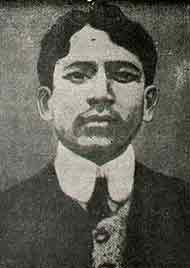 |
| Madanlal Dhingra |
Disaffected with Britain, in 1911, Strickland sold the family home, which became a convent. After 1912, he did not live in England. On August 15 1913 The Argus of Melbourne reported:
baronet," who has been missing from his
accustomed haunts on the Continent for
sometimes, and for whom his friends have
been searching, is reported to be living
quietly at Geneva. He took a prominent
part in the recent formation of a committee
to promote freer trade for India.
Sir Walter, who is the ninth of his line,
and whose title dates from 1641, was born
62 years ago, and succeeded his father four
years ago A scholar and savant of undo
repute, he is called a gipsy and an anarchist,
owing to his wandering habits and politi
cal theories He is a linguist of ability,
verged in both ancient and modem lan
gauges, and won wide fame by his transía
lions of Moliere and Horace.
It is said that during his 62 years he
has spent only 1 week in London
Sir Walter once declared that he had
hidden on the Continent because
absolutely reliable source" that powerful
officials were plotting his assassination. In
Vienna the baronet was arrested because
he was thought to be Ugo Schenek, a
commented the baronet, ' for Schenek was
described as extremely handsome and
title, Sir Walter announced his intention of
removing every scrap of his property to the
Continent, and for the future to have as
little as possible to do with England and
its people.
In a letter to a London newspaper Sir
Walter wrote -"The vulgar, ungentle
manly, and, indeed, murderous
exclusively British " The 'anarchist baronet"
comes of an ancient family that had its seat
at Strickland, in Westmoreland, before the
Conquest, and one of Sir Walter's ancestors,
carried the banner of St George at Agincourt.
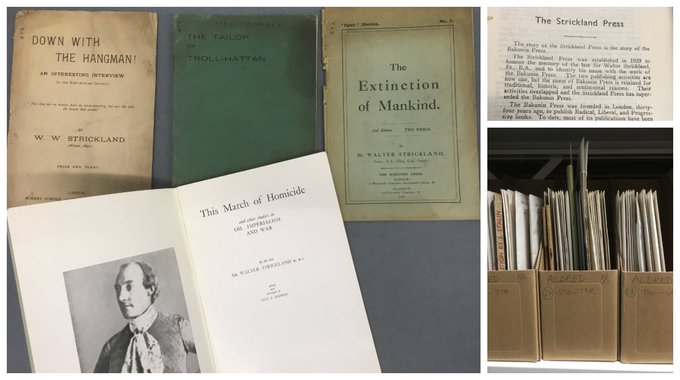 |
| Archive box no 27 of Aldred Collection: Socialist pamphlets by Strickland; the photo seen is Strickland, just out of Cambridge |
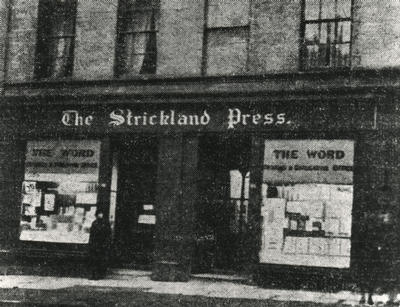 |
Raman wrote to Hitler: "You seem to attribute more importance to the colour of the skin than to the blood. Our skins may be dark; not our hearts".
Hitler sent his Secretary to Raman to apologize but expressed his irritation at being attributed with a black heart. Their friendship came to an end. In January 1933, Hitler became the Chancellor. Nazis raided and arrogated Raman's house in Berlin; he was manhandled and bundled out. He moved to Italy for treatment. Blood had clotted in his brain. He had no money for treatment. He died on 28 May 1934, in an ordinary nursing home. Hitler killed him.
His wife, Lakshmi Bai from Satara in Maharashtra returned to Mumbai with his ashes in 1935. She had valuable documents on Raman. She lived alone in a flat in Church Gate allotted to her by Morarji Desai. She died in December 1972 in St George Hospital, due to starvation. The unidentified body was identified by Journalist P K Ravindranath. Her famished fingers still clenched 17 keys that protected her husband's documents. The documents were transferred to the National Archives.
Padmanabha Pillai returned to Trivandrum and became a Curator with the help of the royal family. During this period, he went to the University of Bern to present a paper on frogs. On his way back, he disappeared without a trace, but his coat was retrieved from a beach in Thailand; his belongings reached Colombo. His father-in-law burned all his remaining documents. Butterflies, spiders and frogs do exist.



